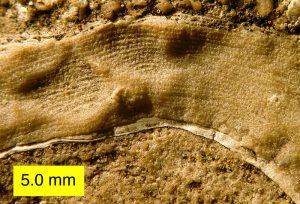The Wikipedia page on sponges is information-rich and accurate on our simple sponge friends. If you really want to get serious, visit the webpage of the International Association for the Study of Fossil Cnidaria and Porifera. You may also want to see the Fossil Sponges of Kentucky. For that matter, Indiana sponges want equal time! And the Sponges of Kansas! (They use Lincoln pennies for scale, just like I do in the field.) Here is a nice sponge educational page from Cortland. Note the embedded links to images.
Here’s a sad story on the last of the Greek sponge fishermen. Pollution, climate change and over-fishing have done in an industry thousands of years old.
Want to cheer up with a few movies of sponges? Of course you do! Watch a sponge feed, for example. The plots are a little thin, but the scenery is magnificent. And everyone must see the sponge final countdown. Oh yes, you must! Twenty-three million viewers can’t be wrong.

Stromatoporoid in side view showing pillars and laminae. Columbus Limestone (Devonian of Ohio).
Geology in the News –
The largest specimen of Ichthyosaurus has been found in a German museum. It is three meters from snout to tip of tail. It is a pregnant female and a cool specimen. No paleontologist calls them “sea dragons” by the way.
A new Devonian fish found in northern China is challenging the current model for the origin of amphibians (so essentially us as well). I don’t yet fully understand how it fits in, so I’m reserving judgement until I know more.
Good review of a new book on extinctions: The Ends of the Earth. Sounds like it is well-written, up-to-date, and topical seeing how climate change is the root of most of our catastrophes.
